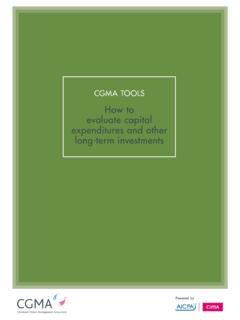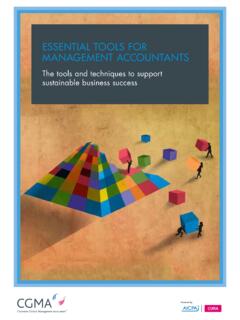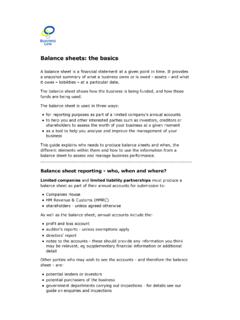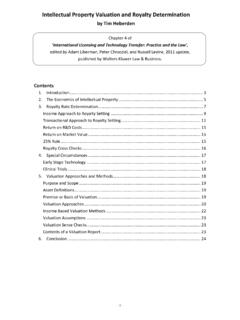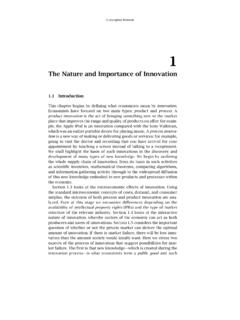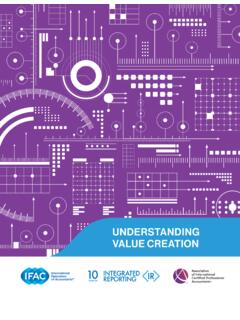Transcription of Three approaches to valuing intangible assets
1 Powered byCGMA TOOLsThree approaches to valuing intangible assets1 Introduction2 Conducting a Valuation of intangible Assets3 CONTENTsTwo of the world s most prestigious accounting bodies, AICPA and CIMA, have formed a joint-venture to establish the Chartered Global Management Accountant (CGMA) designation to elevate the profession of management accounting. The designation recognises the most talented and committed management accountants with the discipline and skill to drive strong business approaches To valuing inTA ngible AsseTs2 Box 1: intangible asset Characteristics Identifiability. intangible assets can be identified specifically with reasonably descriptive names and should see some evidence or manifestation of existence such as a written contract, license, diskette, procedural documentation or customer list, amongst others.
2 The intangible assets should have been created at an identifiable time (or event) and be subject to termination at an identified time (or event). Manner of acquisition. intangible assets can be purchased or developed internally. Determinate or indeterminate life. A determinate life will usually be established by law or contract or by economic behaviour and should have come into existence at an identifiable time as the result of an identifiable event. Transferability. intangible assets may be bought, sold, licensed or rented and are subject to the rights of private ownership, ensuring a legal basis for financial reporting under US generally accepted accounting principles, the definition simply is, assets (not including financial assets ) that lack physical substance.
3 The most important difference in this definition is that it excludes goodwill, which is separately defined as the excess of the cost of an acquired entity over the net amounts assigned to assets acquired and liabilities assumed. Financial goodwill also includes any intangible assets that do not meet the recognition criteria in the financial reporting from tangible assets that have financial substance (things like cash, accounts receivable or prepaid expenses) or physical substance (fixed assets such as equipment), intangible assets show several characteristics that are described in box assets ( intangibles ) are long lived assets used in the production of goods and services. They lack physical properties and represent legal rights or competitive advantages (a bundle of rights) developed or acquired by an owner.
4 In order to have value, intangible assets should generate some measurable amount of economic benefit to the owner, such as incremental turnover or earnings (pricing, volume and better delivery, amongst others), cost savings (process economies and marketing cost savings) and increased market share or visibility. Owners exploit intangibles either in their own business (direct use) or through a license fee or royalty (indirect use). The International Glossary of Business Valuation Terms (IGBVT) is a glossary of business valuation terms that defines intangible assets as non- physical assets such as franchises, trademarks, patents, copyrights, goodwill, equities, mineral rights, securities and contracts (as distinguished from physical assets ) that grant rights and privileges, and have value for the owner.
5 INTRODUCTION3 Box 2: Common Financial Reporting AssignmentsIn financial reporting, intangible assets are valued on a control basis, and the total value of the intangible is estimated rather than the equity in the intangible . In other assignments, some proportion or fractional interest of the rights or total ownership in equity may be the subject being appraised. Financial reporting (goodwill allocation, goodwill impairment and intangible asset impairment) Purchase price allocation Goodwill impairment Accounting for impairment or disposal of long lived assets Taxation (all levels of government) Charitable contribution Gift or estate Compensation paid ( intellectual property) Basis of transferred assets in partnership Transaction, merger, contribution to joint venture, acquisition and fairness opinion Financing, loan collateral or securitisation Litigation (infringement damage, contract breach, marital dissolution, anticompetitive behaviour and attorney malpractice)
6 Transfer pricing (US Internal Revenue Code Section 482 studies related intercompany parties in different tax jurisdictions) Licensing and royalty rate decisions Bankruptcy and reorganisation analysisValuation assignments must estimate the value of intangibles , recognising the volatility, on-going creation and problems with protection and enforcement. Business valuation analysts have been independently valuing intangible assets for many years, usually in the context of an exchange between owners (transaction), for estate and gift tax purposes or as part of a litigation assignment. Knowledge underlies the creation of value. Some of the questions that need to be answered include the following:CONDUCTING A VALUATION OF intangible Ass ET s What would a willing buyer pay to employ the intangible asset ?
7 What is the useful life of this asset ? What portion of the operating income does this asset generate?Financial reporting concepts require measurement of these separable intangible assets from the overall goodwill in a purchase price allocation, attributable to an acquisition (price paid over tangible assets and assumed tangible liabilities) and periodic testing of intangible assets and unallocated residual goodwill for impairment. I ve included some of the most common types of assignments in box approaches To valuing inTA ngible AsseTs4Is an intangible asset valuation assignment different from a more standard, or traditional, business valuation assignment? Well, yes and no. I just want you to know that I am being very decisive here.
8 While it is true that one particular valuation method might be wrong precisely for a particular intangible asset , there are usually several valuation methods that would be approximately right, and while arguments exist for the use of each of these methods, there may be no clear winner. Doesn t that make you feel better?In undertaking the intangibles assignment, there are common planning elements for all valuation assignments, such as the following: Purpose and objective of the analysis Defining the subject intangible asset Understanding the legal rights subject to analysis Date of value Highest and best use considerations Report writing telling a story analysis should be replicable1 However, data collection will probably be different in the intangibles assignment.
9 We need to consider the following: History and development of the intangible asset Owner or operator, or both Licensee or licensor, or both Industry operations and pricing data Competitive environment Commercial comparative intangible assets , cost and treatmentThe minor exception to approaches and methods to be used in intangible asset valuation assignments is that the asset based approach will be referred to as the cost approach. There will be a few minor twists in the application of these approaches , but they are similar. As in all valuations, all Three approaches should be considered. Here are a few ideas on methodologies and the inherent struggles in using each ApproachObservable (one might say findable ) market based transactions of identical or substantially similar intangible assets recently exchanged in an arm s length transaction are often difficult to obtain.
10 Publicly traded data usually represents a market capitalisation of the enterprise, not singular intangible assets . Market data from market participants is often used in income based models, such as determining reasonable royalty rates and discount rates. Direct market evidence is usually available in the valuation of internet domain names, carbon emission rights and US Federal Communications Committee licenses (for radio stations, for example). Consider the following:1. Search for sale/license transactional data2. Issue of comparability and timing3. Selecting/adjusting price multiples4. Selecting/adjusting royalty ratesIncome ApproachIncome based models are best used when the intangible asset is income producing or when it allows an asset to generate cash flow.

